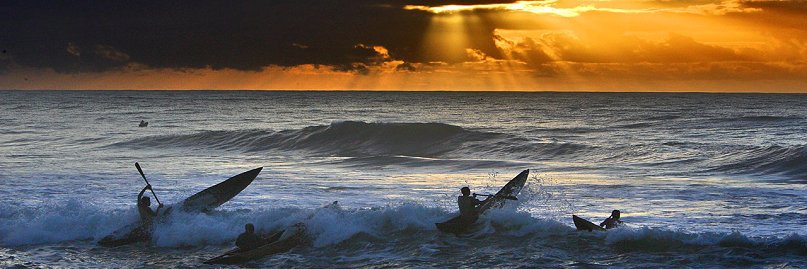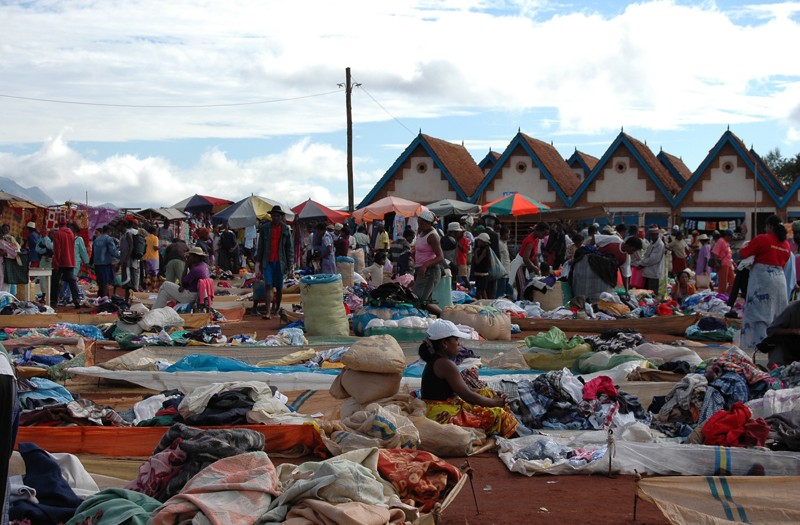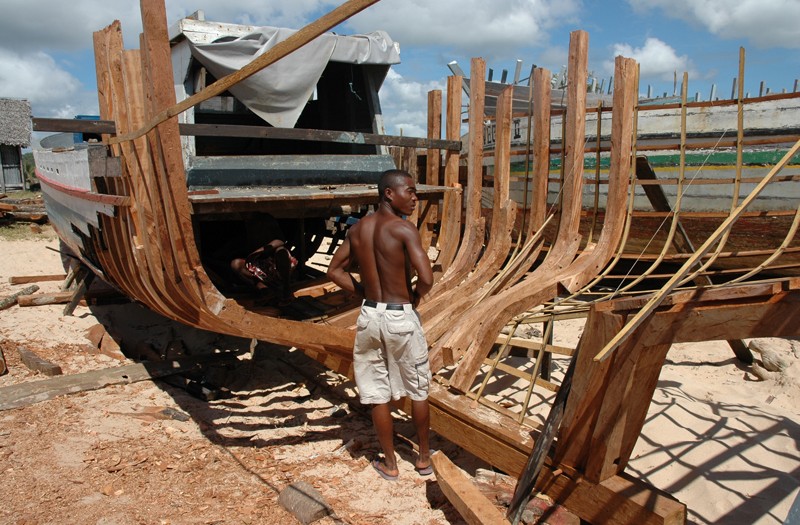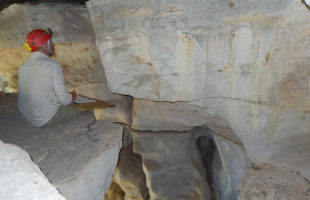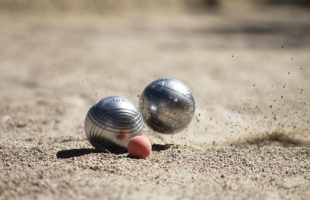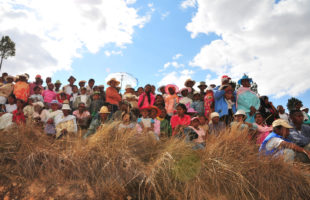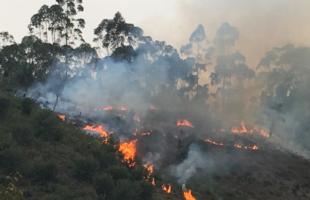Madagascar’s population consists of 18 ethnic groups, some of which differ greatly in their appearance, their traditions and their beliefs. Although statistically 50% of Madagascans are Christians, most people still live in their old traditions with their own faith and according to the old legends. Here we would like to present the people of Madagascar, their origins and ways of life.
Each ethnic group of Madagascar wears its typical clothes and has its own dialect. People have different facial features depending on their original origin, some also wear facial paintings. The map at the bottom of this page shows the approximate location of the habitats of the 18 different Malagasy ethnic groups. These do not coincide with the 22 regions and 6 provinces of Madagascar.
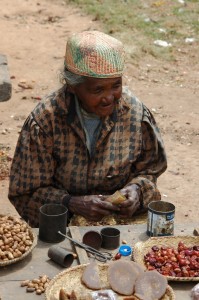
“Merina” means “those who always come back home.” They originate from Indonesia, which is still reflected in their facial features today. This ethnic group, to which most Madagascans belong in number, lives in the highlands of and around Antananarivo, the capital of Madagascar. Historically, the Merina were already rulers of Madagascar in the 16th century, until the country was declared a French colony in 1897. They were also involved in the slave trade in the early 19th century. From its long history has remained the division of Merina into three classes, the Andriana (noblemen), Hova (citizens) and Andevo (slaves). The Andriana are divided hierarchically into seven further subgroups. Merina men traditionally wear the Malabary, a special red dress. Their language is one of Madagascar’s three official languages. Merina boys are traditionally circumcised in a seven-yearly ceremony, as is common in many other ethnic groups.
“Betsileo” mean “the Invincible”. They are specialists in terraced rice cultivation and famous for the turning of the dead, the Famadihana. This tradition is also cultivated in the Merina, also inhabiting the highlands, with which Betsileo is closely connected. Besides the well-known burial rites, this ethnic group is known for its Vatolahy, stone stelae. In former times they were used to mark the kingdom’s borders, today Vatolahys are also set up for festivities and special occasions. Like the Merina, the Betsileo are still divided into classes into which people are born. However, this classification does not always have a real influence on social life. The Betsileo live around Fianarantsoa in eastern Madagascar and were historically divided into several small kingdoms until King Radama I. united them. Many Betsileo were enslaved and sold to Europe.
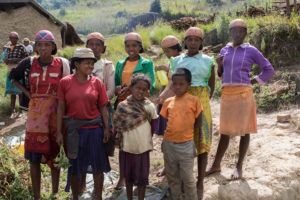
Although the majority of the people of the highlands officially live as Christians, many old forms of faith are still preserved and mixed with Protestantism and Catholicism. In addition to the belief in Zanahary, who is said to have written the Sorabe, the Betsileo have also retained traditional roles such as that of fortune tellers, astrologers and shamans. The dialect of Betsileo has a very typical pronunciation, which contains many “shhh”, “gn” and so on. A well-known typical Betsileo tradition is the Zebu Rodeo, in which young men demonstrate their courage. The Zafimaniry are a subgroup of the Betsileo, who are especially famous for their woodcarving.
“Betsimisaraka” is the Malagasy word for “inseparable”. This ethnic group lives on the east coast, most of them are fishermen in the Indian Ocean or on the Canal des Pangalanes, some others have learned to grow vanilla and cloves on plantations. Its largest city today is Toamasina (Tamatave). The Betsimisaraka represent one of the largest ethnic groups of Madagascar and consist of many small subgroups similar to the Sakalava.
When Betsimisaraka die, the remaining pirogues are used as coffins and raised under roofs near the beach. Zebu victims also play an important role in faith, as can be seen in the fisokonas, wooden posts decorated with horns and patterns in the villages. The fisokonas are used to call the ancestors and ask for help or advice. The blood of the sacrificed zebus is scattered over the fisokona. Besides the ancestor cult many Betsimisaraka believe in Kalanoro, small, long-haired mythical creatures of the forest, which possess magic powers. Another very important part of the Betsimisaraka’s traditions is the Basesa, a rhythmic dance that is celebrated on all kinds of occasions.

The founder of the Kingdom of Bestimisaraka was Ratsimilaho, who is said to have emerged from the marriage of an English pirate to an Anteva princess. He united the various subgroups to the Betsimisaraka ethnic group and became their first king. Later, until the colonization of Madagascar, the Betsimisaraka came under the domination of the Merina.
The “Sakalava” were the first ethnic group to form in Madagascar and descended from the African Bantu. Their name means “those who live in the long gorge”. The home of the Sakalava extends from southwest Madagascar to the north to the island of Nosy Be. Morondava and Mahajanga are among the most important cities. In the north they are among the farmers of the large coffee and cocoa plantations. Historically the Sakalava were for a long time a ruling ethnic group of Madagascar, who sold people as slaves to Europe in exchange for weapons and other valuables. Even today they are still the second largest ethnic group of the country, but of course the slave trade dates back several centuries. Every seven years, families with male children celebrate a big festival in which the boys are circumcised. It is a tradition that the boy’s grandfather eats the cut off foreskin afterwards.
Other ancient customs are the Doanys, where bones of deceased kings of the Sakalava are kept. At regular intervals the mortal remains are brought back into the circle of the living in a ceremony called Fitampoha, washed in the river and brought back to Doany. The Sakalava still use trombas today: these are people into whom the spirit of an ancestor has gone during a kind of trance and speaks to the living. Many modern Sakalava still encounter trombas and believe in their connection to the deceased.
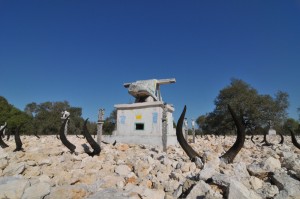
The ethnic group of “Masikoro” are famous for their myths and legends. Almost all of Madagascar’s legends known today were once told by their ancestors. Nowadays the Masikoro live on agriculture. They are usually counted among the southern living Sakalava, which is why they practically represent a “19th ethnic group”. According to legend, the Masikoro have a common ancestor with the Bara tribe and originally come from the same area. Today the Masikoro share their land with the Vezo.
“Antandroy” means “those who live in the spiny forests”. And they live there too: in the deep south of Madagascar around Fort Dauphin. The Antandroy are nomads who, unlike most Madagascans, do not feed mainly on rice because their environment is too dry for cultivation. Many Antandroy still live according to old customs, for example, protective amulets are still very important today. The music of Antandroy, Beko, is quite well known as it is celebrated to traditional dances with spears, drums and flutes. At Antandroy’s funerals, guests and family eat all the deceased’s cattle and then burn his or her house down. This custom is to protect the house and its village from being haunted by the spirits of the ancestors. The grave of the deceased, on the other hand, must be built according to certain rules, and the construction can take a long time.
The “Mahafaly” are the inventors of the fady in Madagascar, which means sacred or taboo. The people are famous for their hand-carved wooden totems, aloalo, standing on the Mahafaly graves, telling visitors stories of the deceased and honoring kings or other important members of the village community. On the graves there are also zebu horns and small woodcarvings. Many families are in debt in order to build a magnificent grave for their relatives. The Mahafaly live in southwest Madagascar.
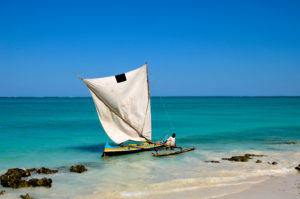
The “Vezo” originally came from East Africa and today live as semi-nomadic fishermen in southern Madagascar, in the area between Toliara (Tuléar), Intampolo, Morondava and Mahajanga. With their narrow, self-built mangrove pirogues, they venture into the sea even in high waves to wring fish and seafood from the angry sea for a living. Even today, they still only hunt with nets, spears and lockers; money is rarely available for motorboats. The Vezo are said to be such a proud people that Vezo should never sleep on the floor. If a child is born at the Vezo, the associated placenta is put into a bottle and sunk into the sea – only then is the child itself a Vezo. Circumcision of male children is an old tradition that is celebrated every seven years (similar to Sakalava) with a big feast. The shaman of the Vezo is called Hazomanga, he is a mediator between ancestors and living families and occupies one of the most important positions in the village. Funerals at the Vezo are held in their own cemeteries in the forest, far away from the villages.
“Bara” are an important tribe of cattle farmers living around Ihosy in southern Madagascar. They are originally descended from African Bantu and look similar. Their most famous tradition is that young men have to steal a zebu to prove their courage to the parents of their loved ones before marriage and to pay the cattle as a price for the future bride. This still leads to many disputes between the ethnic groups in the south and again and again also to the death of the cattle thief (dahalo). However, before a proposal for marriage is made, young men and women meet, the former showing with a comb in their hair that they are still available and giving their chosen ones the appropriate oil for hair care. The Bara traditionally wear certain pigtail hairstyles.
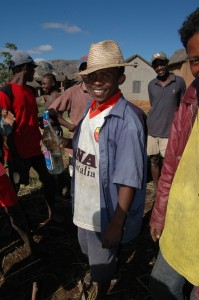
Most Bara live polygamously, which exacerbates the problem of the many cattle thefts. Like the Betsileo, the Bara are also practicing Zebu rodeos, with young men trying to stay on the back of angry zebus as long as possible. When a Bara dies, he is buried in natural caves. The bereaved cut their hair to express their grief and to commemorate the deceased. With the Bara, the spirits of the dead are perceived as danger, so that it can also happen that whole villages move after the death of a respected villager to protect the living.
“Antakarana” is a Malagasy expression for “those who live in the needle rocks“. This ethnic group lives mainly from hunting. Its home is the region of the north from Ambilobe to Antsiranana (Diego Suarez). According to history, they fled to the cave systems under the Tsingys of Ankarana during Merina attacks. Since the remains of their ancestors lie there, the Antakarana forbid the Merina tribe to enter the caves of today’s National Park with a fady. Every five to seven years the Antakarana celebrate the King’s Feast, Tsangatsaina. The potential king has to raise the Malagasy flag – if he does not succeed, he loses his right to rule.
The “Antemoro” descend from Arabs and live today in the southeast of the country around Manakara and Farafangana. According to legend, the founder of this ethnic group was Ramakararo, a sultan from Mecca. The Islamic faith brought from there still plays an important role among the Antemoro. Pigs are unclean to this ethnic group, they are not allowed to keep dogs and still today there is an old caste system with nobles (Anteony), intellectuals and clergy (Antalaotra) as well as the lowest class, the former slaves. The Antemoro are known as “the tribe of paper manufacturers”. They used to make the handmade paper called Antaimoro from mulberry bark to write the Koran and the Sorabe. Today this old craft is still passed on. The stargazers of Antemoro were also famous during the time of the Malagasy kings, from which the culture of ombiasy (stargazers of a village) probably developed in all of Madagascar.
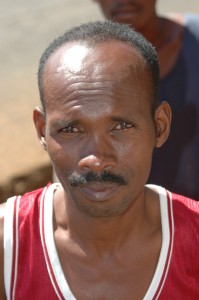
“Antesaka” is a shy, quiet ethnic group living on the east coast around Vangaindrano. The ethnic group was founded around 1650 by Andriamandresy, a prince of Sakalava. He was banished from Menabe with some of his warriors after murdering his uncle out of greed and being jealous of his brother, whom the people preferred as their new king. At the beginning of the 17th century, the kingdom of Antesaka was one of Madagascar’s largest. From 1820 until colonization by France, the country was occupied by Merina, who killed captured Antesaka men and enslaved women and children. Today the Antesaka live from the cultivation of rice, coffee and bananas, partly also from fishing. Like the Antambahoaka, twins are killed after birth or left to die in the forest, as fadys command this tradition. If an Antesaka dies, his body is taken outside by an eastern door built especially for this purpose, where he dries for several years. At the end of a certain period of time, the Tranondonokay is celebrated, which lasts until the next morning. Only then is the dried out, oiled body of the dead man brought to a funeral home called Kibory in a forest that is fady for everyone except men.
“Antefasy” in English means “those who live in the sand”. This expression describes their habitat quite well: they live around Farafangana, in the dry and hot southeast of Madagascar. They are closely associated with the Antesaka. The founder of this tribe is Ndretsileo, who came from Africa and whose grandson Ndrembolanonys son Marofela called his clan Antefasy. It is said to him that the people of his kingdom shall become as endless as grains of sand in a desert. During the occupation by Merina in the 19th century, the Antefasy fled to the island of Anosinandriamba. But even there they were surprised by Merina, the men killed and the remaining Antefasy were taken as slaves. Today the Antefasy traditionally live in three tribes, each with its own king. They earn their living growing rice and fishing in lakes and rivers. Like the Antesaka, the Antefasy use a kibory to bury their dead.
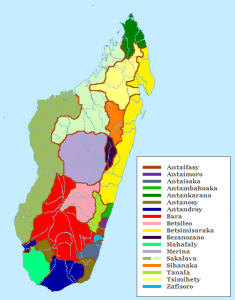
“Antambahoaka” is an ethnic group living in southeast Madagascar. They are the smallest tribe in Madagascar and believe in their ancestors and King Raminia Rabevahoaka, who is said to have come from Mecca around the 14th century, and still trust in their ancient monarchies. The sad fame of this ethnic group of Madagascar today comes mainly from the custom that newly born twins are killed or abandoned. According to legend, a fire raged in the village of Antambahoaka hundreds of years ago. A mother of twins escaped with one of her babies. To save the second baby too, she went back to the burning village – and died a tragic death in the flames. Through this story, twins are still seen today as bringer of bad luck or even death. Kanamba, i.e. twins, are fady – a mother who does not want to abandon or kill her children is excluded from the community. Meanwhile, there are some orphanages in the Mananjary area that take care of the abandoned – and actually not orphaned – children. A less horrible custom is the circumcision of the Antambahoaka boys, as it is celebrated in many areas of Madagascar. Every seven years, the Antambahoaka celebrate a great festival called Sambatra in Mananjary.
“Tsimihety” come from the northwest of Madagascar, their cities are Antsohihy, Port Berger and Bealanana. The name means “those who don’t get their hair cut”. This name refers to the tradition, which is still alive today, that Tsimihety grow their hair long for a few years after the death of a loved one as a memento. Originally the long hair is said to have been a symbol of resistance against King Radama I., who wanted to impose the customs of Merina on Tsimihety. The Tsihimety live mainly from the cultivation of tobacco, cotton, fruits and other agricultural goods. The oldest uncle on the mother’s side is traditionally the head of the family.
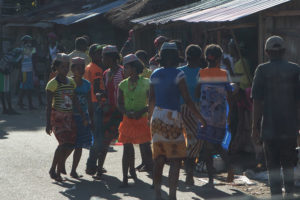
“Tanala” means something like “those who live in the forest.” They have their home today southeast of Fianarantsoa and were long rainforest inhabitants. The Tanala are the secret keepers of Madagascar’s traditional plants and are known for taking only what they need to live. However, with the advent of national parks and protected areas and, of course, slash-and-burn farming, it is difficult for the Tanala to preserve their old traditions and habits.
The “Bezanozano” people are best known for their inglorious past as slave sellers and scalves even in the 11th century. Today, they earn their living mainly by producing coal. The Bezanozano are said to have been one of Madagascar’s first ethnic groups. Her name, which means “the one with the many little plaits”, points to her typical hairstyles. They live in the area around Moramanga.
“Sihanaka” is an ethnic group living in the fertile area around Ambatondrazaka and Lake Alaotra, north of the capital Antananarivo. They cultivate rice (the region is also called Madagascar’s rice chamber) and look after fish farms with mainly tilapias as food fish. A well-known custom is the Ambalavelona, which says that a man can win the heart of his beloved by magic. There is also a holy village, Andrebabe, whose inhabitants are said to wear buttoned shirts on their backs. These and many other ancient beliefs and legends strongly influence the Sihanaka.
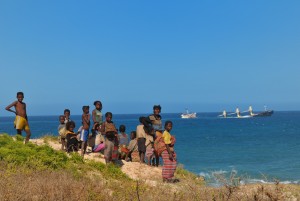
“Antanosy” live in the Anosy region in southeast Madagascar. Some also live near Bezaha west of the river Onilahy, where their ancestors fled after the conquest of Antanosy by Merina in the 19th century. Today they are one of Madagascar’s smallest ethnic groups and live on rice, cassava, fruit, etc. The first evidence of their presence on the island dates back to the 9th century. Since then Anosy have experienced an eventful history of wars, occupations, uprisings and changing rulers. Stone monuments reminiscent of their ancestors and zebus as a dowry for brides are still a visible tradition today. Most Antanosy men have several wives.
 MADAMAGAZINE Your Magazine about Madagascar
MADAMAGAZINE Your Magazine about Madagascar
